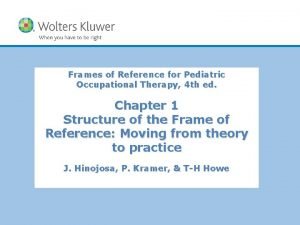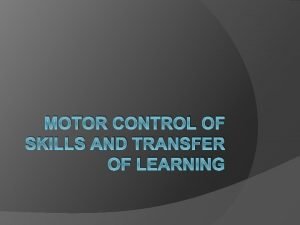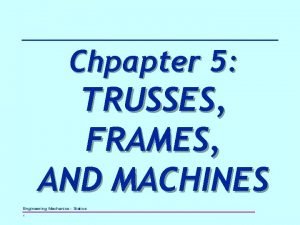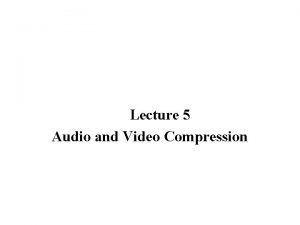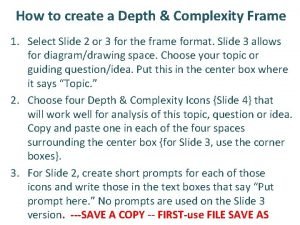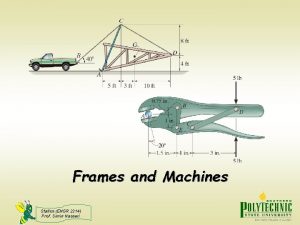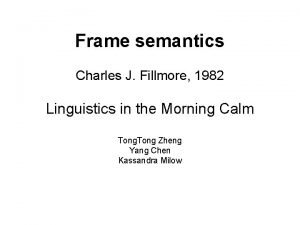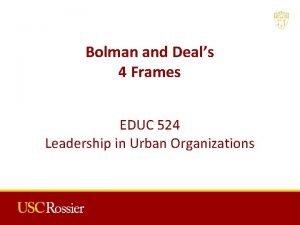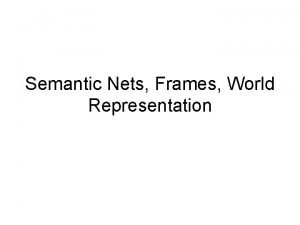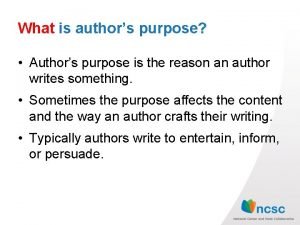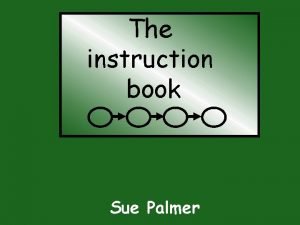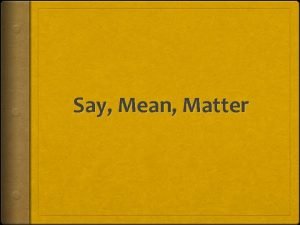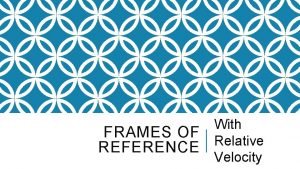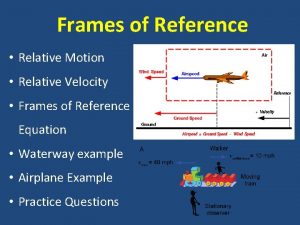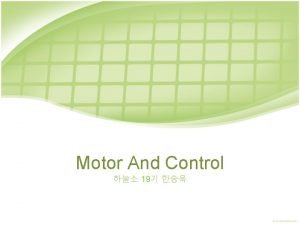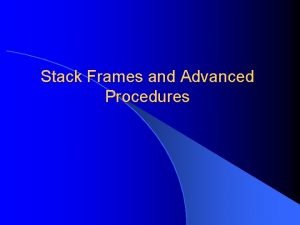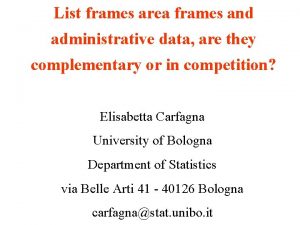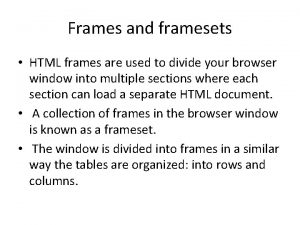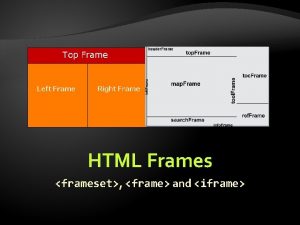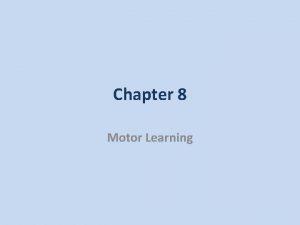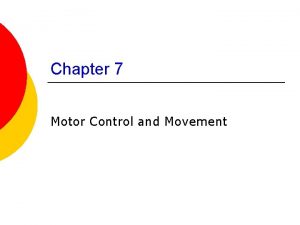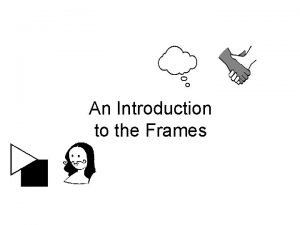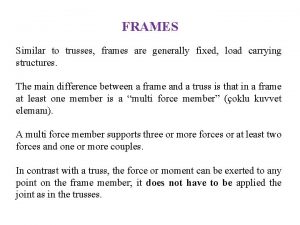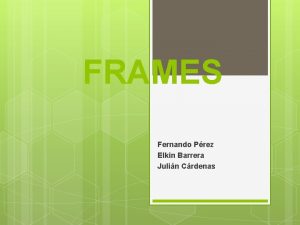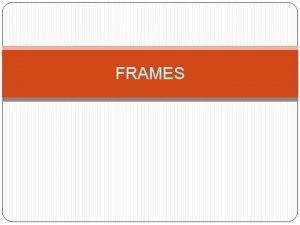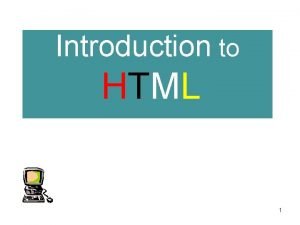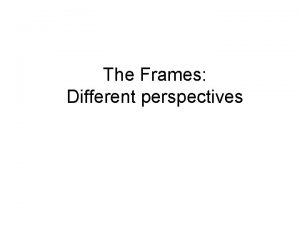Motor Control and Motor Learning Frames of Reference






















- Slides: 22

Motor Control and Motor Learning Frames of Reference

WALLY 68 year old, black male, married for 30 years Job – caretaker in a church Home – lives at the church in a basement apartment Suffered a left CVA, leaving right arm and leg flaccid, speech slurred and dysarthric, and is depressed Concerns – his wife will not be able to care for him and he will have to go to a nursing home. He also cannot work so they might have to go on welfare and may not be able to afford their apartment Medical history – hypertension for 9 years, history of ulcers, had retinal surgery 6 years ago, no history of psychiatric illness

WALLY Mental and physical status – appears to be very neat, clean and well groomed. Inconsistent eye contact, especially when approached from the right side. Motor ability is impaired and does not ambulate at this time. Right arm and leg are flaccid and has right facial droop. Slurred speech and difficulty finding words. Affect is depressed since the injury. Formal thought is confused and has perceptual deficits which include visual disturbances, crossing the midline, figure-ground difficulties, and severe right neglect.

Neurodevelopmental Therapy Approach • Movement control progresses from head to foot, trunk to limbs, and from large to small • It focuses on stability before mobility • Goal is to regain control over primitive reflexes for skilled voluntary movement.

How do you as Wally’s OT apply the Neurodevelopmental Therapy Approach to his ADL’s? • Handling and Practice • compensation is discouraged • encourage Wally to use more of his affected sides for ADL’s • Bathing • Transferring himself from one location to another • Dressing • Feeding

Wally’s Functions & Disability (using NDT perspective) • Loss of selective movement control in his right arm • abnormal tone on affected side (right side is flaccid) • poor inhibition of primitive reflexes and/ or nonfunctional movements 3 Goals to work on for Wally: • Refining tone in his affected right side • Regaining more movement in affected right side • Strengthening fine motor skills and stability overall

Can you name a few common routines or tasks you feel Wally should concentrate on? 1. Transferring (stability getting from wheelchair to bed, or restroom) 2. Bathing 3. Dress *Wally has been confused in his formal thoughts with routines and ADL’s therefore, with practicing certain tasks over and over, he will be able to remember and master these tasks.

What recommendations would you give Wally’s wife as far as carrying out NDT training? • Make sure she is aware of what Wally is capable of. • Have her encourage Wally to use more of his affected side to strengthen bilateral movement • Place items closer to his affected side to induce spontaneous movement of his affected side • Have Wally help her with various tasks and chores around the house for strengthening his affected side

Motor Learning Approach • A general rehabilitative approach to all forms of movement abnormalities and disorders • Holistic or systems approach • Directly relates to specific task performance • Aims at restoring functional movement using meaningful tasks so that clients have the motivation to continue with interventions

Wally’s function and disability using a contemporary task perspective In a contemporary task perspective, functioning is defined within the context of specific tasks and there is a gradual increase in the degrees of freedom within which skilled movements are performed. Identifying specific tasks for Wally and defining function and disability Returning to work – impaired: Wally is unable to perform all the things necessary for his prior occupation ADLs – functional : Wally still has use of his unaffected side and through continued practice and support of the affected side Wally will gradually regain function on the affected side Mobility - impaired : Currently Wally in unable to ambulate. He is in a wheel chair and will eventually become mobile through the use of his wheelchair as he continues to strengthen his transferring skills. Social participation – functional: Although Wally has some speech difficulties, he is able to communicate and will continue to regain his speech and language

What three tasks might Wally choose to focus on as implied in the case? Muscle strengthening Crossing the midline Establishing independence in activities of ADLs Dressing Bathing Transferring

What tasks would be priorities for Wally’s wife for when he returns home? Increasing his motivation Having Wally perform purposeful & meaningful activities

Describe the procedure you would use to evaluate Wally’s ability to perform the task he has chosen. Conduct evaluation during occupational & role performance in natural settings Dressing at home Observe Wally performing functional tasks in various contexts Transferring from wheelchair to bed, from toilet to wheelchair, etc.

Use one of these as an example and describe your approach in detail. Dressing Teaching a set pattern for dressing Giving cues to distinguish right, left, front & back Lay out clothing in order which you will put them on Sit down while dressing Put the affected limb into the piece of clothing before the unaffected arm or leg

How would summarize an intervention plan for Wally using the motor learning approach? Practice dressing, bathing, transferring in a natural setting Practice whole tasks, not isolated parts Provide feedback Encourage self-evaluation & error detection

NDT vs. Motor Learning: Similarities and differences in descriptions of occupational problems and goals for Wally Both NDT & Motor Learning Theory rely on the plasticity of the brain to rewire and make new connections so that Wally will eventually be able to ambulate and use his right side again. DIFFERENCES Neurodevelopmental Theory Occupational dysfunction is characterized by the inability to control one’s own motor movements. Goals to therapy include trunk stability, increased independence in self-care, and restoration of safe mobility. NDT focuses on establishing sensorimotor components that are prerequisites for occupational performance. Motor Learning Frame Three stages of function: cognitive, associative and autonomous stage. Function defined within context of specific tasks. The goal is to restore functional movement by developing optimal motor and cognitive strategies. Recovery is reached when the person is restored to their previous level of abilities as before the accident.

Similarities and differences in approach to evaluation NDT Motor Learning Initially occurs in clinical setting Conduct in natural setting during normal occupation and role performance Involves both observation and handling to determine function/limitations May rely on self-report or caregiver report to determine functional capacity Responses to input are evaluated as well as posture and movement sequences Attributes of person, environment, and task are evaluated Selective control of arms and legs is evaluated segment by segment Observe same task within various contexts SIMILARITIES • Collaborative approach with client and family to determine occupational problems and priorities

How would you use each approach to deal with Wally’s motivational issues NDT assumes that training and practice will produce improvements without intentional effort of the client’s part. Therefore, Wally’s participation in activities that are meaningful to him will be his motivation. Motor Learning frame selects tasks that are challenging and meaningful to the client, and that are identified by the client themselves. We would ask Wally what types of things most important to him and go from there. In both cases, we will most likely be working on tasks that will enable him to go back to work so he and his wife do not have to go on welfare or lose their house.

Differences in intervention strategies and techniques: NDT • Handling • Use of facilitation and inhibition techniques • Placing hands at key points of control • Using reflex-inhibiting patterns/postures (RIPs) • Considered preparatory treatment because it’s directed toward establishing sensorimotor performance components that are prerequisites for occupational performance. Motor Learning • Task oriented approach • Focus on assisting clients in developing the optimal motor and cognitive strategies for achieving functional goals • Remediation, adaptation, and compensation are not separated, but represent one holistic approach • Practice of needed skills in natural settings • Practicing whole tasks, not isolated parts • Providing randomized practice

Changes in environment and task demand in: NDT In Wally’s case, his task demands will change by taking him longer to do certain things such keeping things neat, clean, and being wellgroomed. Environment in the home will need to be changed in order to have easier mobility when he’s in his wheelchair, transferring, and bathing. Motor Learning Early stages of learning: Feedback is focused on movement outcome and the critical features of the task and environment (not on motor performance) • Later stages: Clients are encouraged to self-evaluate their own movement performance and outcome by focusing on feedback from their own body and environment

Role of adaptation and compensation: NDT • Discouraged compensation with one-handed strategies for task performance as counterproductive because it encourages learned neglect • Compensation continues to be discouraged, and use of hemi side encouraged for performing activities of daily living. Motor Learning • Remediation (establish or restore), adaptation, and compensation are not separated, but represent one holistic approach

Which approach would you use with Wally, and why? We would use NDT because Wally has abnormal movement and tone (right arm and leg flaccid) and must be inhibited before normal movement can be restored. His disability include: Loss of postural control and selective movement control Abnormal on the affected side Associated reactions (bilateral movement are not good) Poor inhibition of primitive reflexes Sensory disturbances
 Pediatric occupational therapy frames of reference
Pediatric occupational therapy frames of reference Open loop control motor learning
Open loop control motor learning Reference node and non reference node
Reference node and non reference node Reference node and non reference node
Reference node and non reference node Cuadro comparativo e-learning b-learning m-learning
Cuadro comparativo e-learning b-learning m-learning Cookies frames and frame busting
Cookies frames and frame busting What is truss in engineering mechanics
What is truss in engineering mechanics Effect audio
Effect audio Depth and complexity frames
Depth and complexity frames Frames and machines statics
Frames and machines statics Fillmore 1982
Fillmore 1982 Browser security model
Browser security model Bolman and deal 4 frames
Bolman and deal 4 frames Semantic nets and frames
Semantic nets and frames Motor neuron vs motor unit
Motor neuron vs motor unit Purpose of the author
Purpose of the author The four frames of kindergarten
The four frames of kindergarten Sue palmer explanation text
Sue palmer explanation text Sue palmer recount skeleton
Sue palmer recount skeleton 4 frames kindergarten
4 frames kindergarten Sue palmer instructions
Sue palmer instructions What is say mean matter
What is say mean matter Sentence frames for evidence
Sentence frames for evidence
